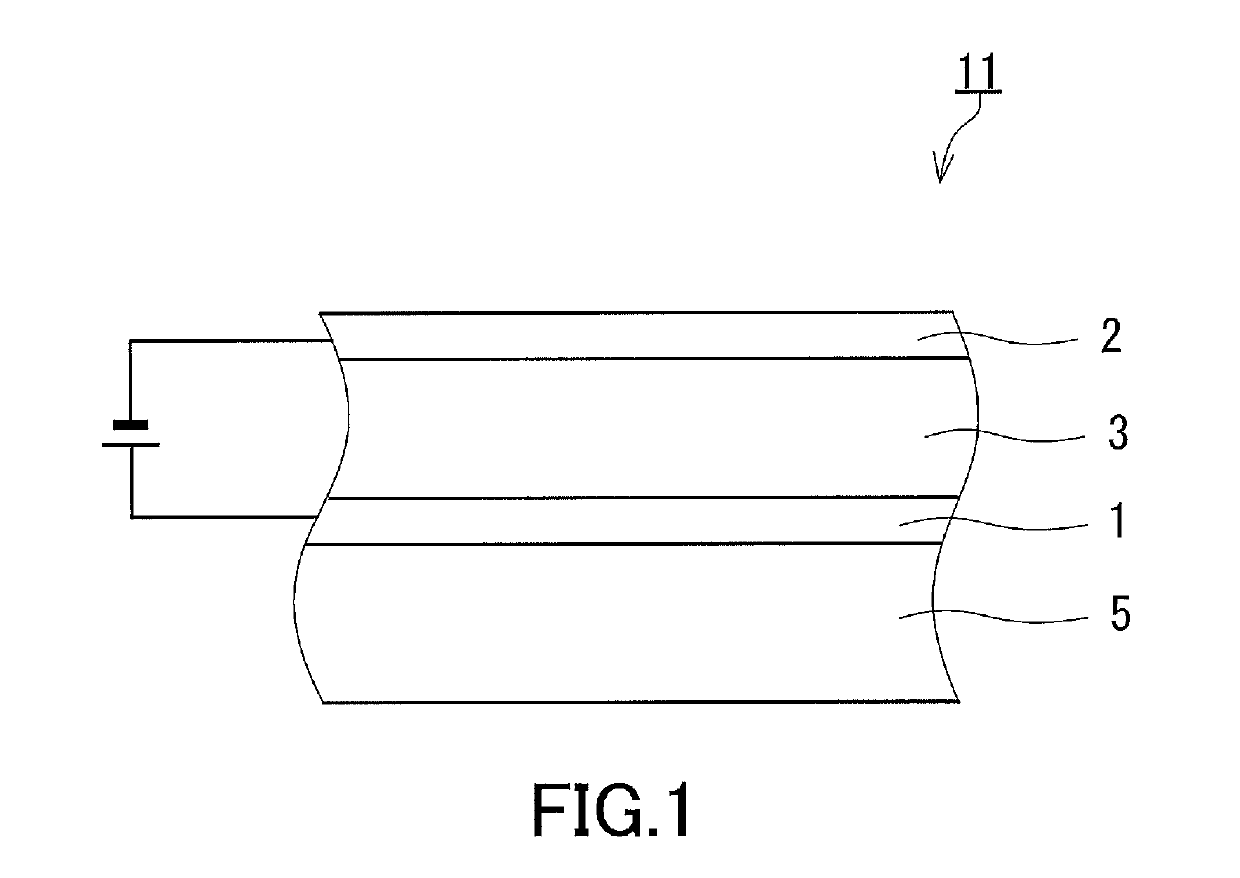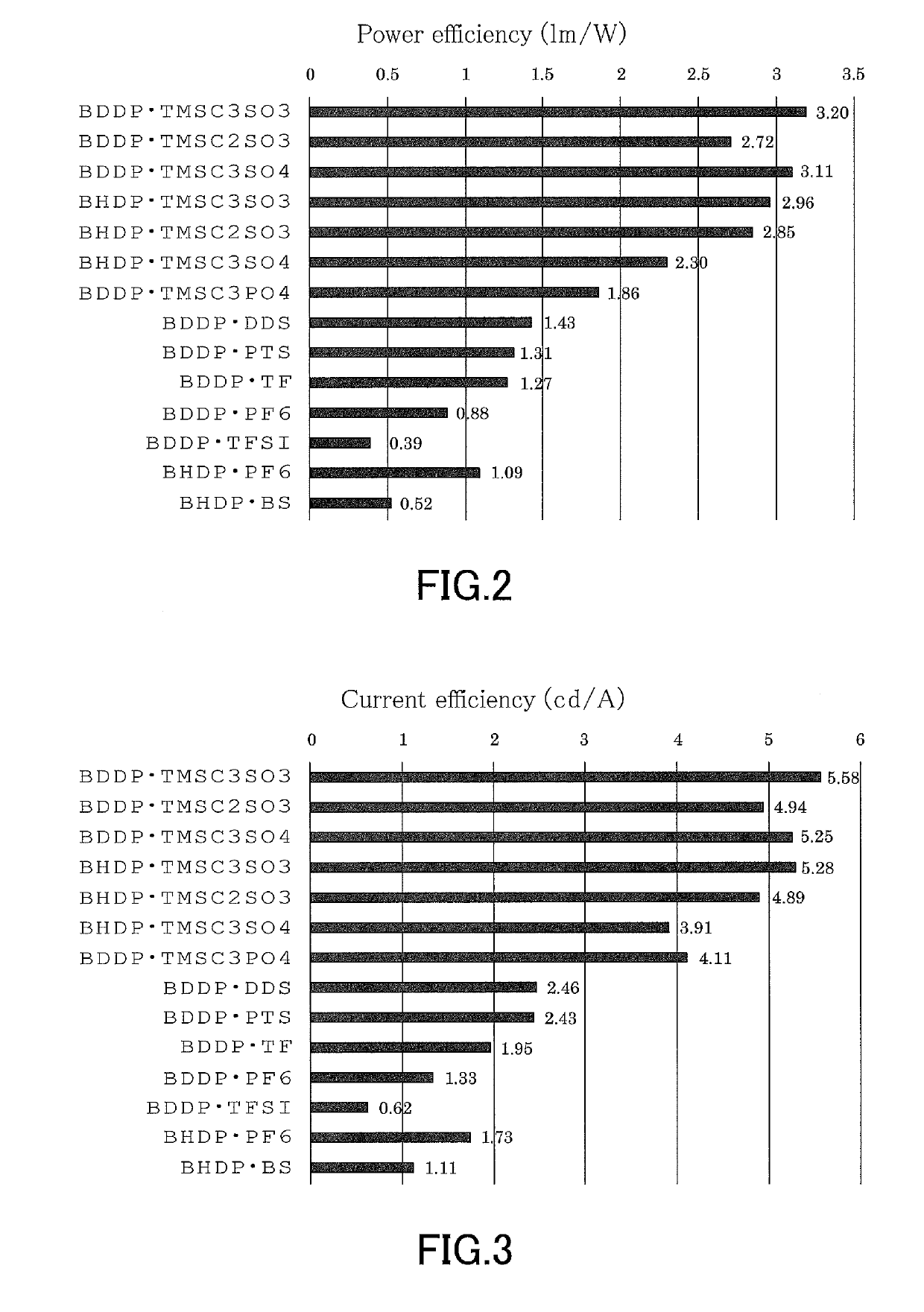Light-emitting electrochemical cell
a technology of electrochemical cells and light-emitting electrodes, which is applied in the direction of luminescent compositions, lighting and heating apparatus, and light-emitting devices, can solve the problems of difficult manufacturing cost reduction of organic el devices and high risk of defects, and achieve the effect of improving light emission efficiency and light emission characteristics
- Summary
- Abstract
- Description
- Claims
- Application Information
AI Technical Summary
Benefits of technology
Problems solved by technology
Method used
Image
Examples
example 1
[0117]A hole injection layer (PEDOT:PSS, manufactured by Heraeus) was formed by spin coating (film thickness: 50 nm) on a commercially-sold ITO-coated glass substrate (manufactured by GEOMATEC Co., Ltd.; ITO film thickness: 150 nm). SY (Super Yellow, manufactured by Merck & Co., Inc.) was dissolved in dichlorobenzene to prepare a 0.46 wt % solution. The dichlorobenzene solution of SY and a dichlorobenzene solution of BDDP⋅TMSC3SO3 (concentration: about 18 mmol / kg) were mixed in a mass ratio of 15:1 to give a light-emitting layer-forming solution. In this mixed solution, the number of moles of BDDP⋅TMSC3SO3 added per 1 g of SY was 2.6×10−4 mol. Next, the light-emitting layer-forming solution was applied by spin coating onto the PEDOT:PSS layer to form a light-emitting layer. The application of the light-emitting layer was followed by heating on a hot plate at 70° C. for 30 minutes to remove dichlorobenzene, and thus a 100-nm-thick light-emitting layer made of SY:BDDP⋅TMSC3SO3 was for...
examples 2 to 7
[0118]Light-emitting electrochemical cells were produced in the same manner as in Example 1, except that ionic compounds listed in Table 1 were used instead of BDDP⋅TMSC3SO3, and the light emission characteristics of the light-emitting electrochemical cells were evaluated. It should be noted that the number of moles of the ionic compound per 1 g of SY was the same as in Example 1. The ionic compounds were synthesized by the methods referred to or described above.
example 8
[0126]Light-emitting electrochemical cells were produced in the same manner as in Examples 1 and 3, except that the numbers of moles (mol / g) of BDDP⋅TMSC3SO3 and BDDP⋅TMSC3SO4 added per 1 g of SY were 1.2×10−4, 1.5×10−4, 2.0×10−4, 2.6×10−4, and 2.9×10−4, and the light emission characteristics of the light-emitting electrochemical cells were evaluated. The results for the maximum light emission efficiency achieved in the measurement are shown in FIG. 4 and FIG. 5.
[0127]From FIGS. 4 and 5, it can be concluded that the appropriate amount of the ionic compound added to the light-emitting material, as expressed by the number of moles (mol / g) of the ionic compound added per unit weight of SY used as the light-emitting material, is generally about 1×10−4 to 4.5×10−4, and that the optimal amount is about 1.5×10−4 to 3.5×10−4 for BDDP⋅TMSC3SO4 and about 2.0×10−4 to 4.0×10−4 for BDDP⋅TMSC3SO3. For both BDDP⋅TMSC3SO3 and BDDP⋅TMSC3SO4, it was confirmed that, although precise measurement was no...
PUM
| Property | Measurement | Unit |
|---|---|---|
| thickness | aaaaa | aaaaa |
| thickness | aaaaa | aaaaa |
| thickness | aaaaa | aaaaa |
Abstract
Description
Claims
Application Information
 Login to View More
Login to View More - R&D
- Intellectual Property
- Life Sciences
- Materials
- Tech Scout
- Unparalleled Data Quality
- Higher Quality Content
- 60% Fewer Hallucinations
Browse by: Latest US Patents, China's latest patents, Technical Efficacy Thesaurus, Application Domain, Technology Topic, Popular Technical Reports.
© 2025 PatSnap. All rights reserved.Legal|Privacy policy|Modern Slavery Act Transparency Statement|Sitemap|About US| Contact US: help@patsnap.com



